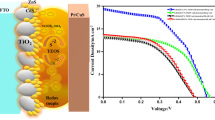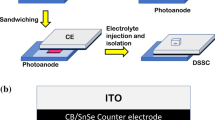Abstract
An intuitive method was designed to measure the performance of various electrolytes for quantum dot-sensitized solar cells (QDSSCs). Cyclic voltammetry (CV) measurements were used to evaluate the electrolyte performance using a standard three-electrode system composed of a working electrode, counter electrode, and reference electrode. CV measurements were carried out over the potential range of −0.7 to −0.1 V at a scan rate of 50 mV s−1 in five different polysulfide electrolytes. A higher reduction peak current in the CV curve indicated a faster rate of the redox reaction (S 2− n to S2−) in the electrolyte. The QDSSCs were assembled into a sandwich structure consisting of a CdS/CdSe co-sensitized photoanode, a PbSe counter electrode, and a polysulfide electrolyte. Photocurrent density vs. voltage curves were measured for the assembled cells. The resulting energy conversion efficiency measurements were consistent with the CV results. An energy conversion efficiency of 5.14% was obtained for QDSSCs using an electrolyte containing 0.05 M 1,2-dimethyl-3-propylimidazolium iodide.
摘要
本文阐述了一种直观判断量子点敏化太阳能电池电解液性能的方法. 采用由工作电极、 对电极和参比电极组成的标准三电极系统, 扫描速度为50 mV s−1, 在−0.7∼−0.1 V的电压范围内对五种不同的多硫电解液进行循环伏安法测定. CV曲线中还原峰电流越高, 表明氧化还原反应速率越快(S 2− n to S2−). 本文所采用的量子点敏化太阳能电池由CdS/CdSe共敏化的光阳极、 PbSe对电极以及多硫电解液为主要结构组成, 测量了光电流密度和电压的曲线. 能量转换效率所显示的结果与CV结果一致. 添加0.05 M的1,2-二甲基-3-丙基咪唑碘盐后的量子点敏化太阳能电池转换效率为5.14%.
Similar content being viewed by others
References
Kamat PV. Quantum dot solar cells. Semiconductor nanocrystals as light harvesters. J Phys Chem C, 2008, 112: 18737–18753
Yang Z, Chen CY, Roy P, et al. Quantum dot-sensitized solar cells incorporating nanomaterials. Chem Commun, 2011, 47: 9561–9571
Han L, Wang YF, Zeng JH. Effectives solid electrolyte based on benzothiazolium for dye-sensitized solar cells. ACS Appl Mater Interfaces, 2014, 6: 22088–22095
Hodes G, Manassen J. Electrocatalytic electrodes for the polysulfide redox system. J Electrochem Soc, 1980, 127: 544–549
Cong JY, Yang XC, Hao Y, et al. A highly efficient colorless sulfur/iodide-based hybrid electrolyte for dye-sensitized solar cells. RSC Adv, 2012, 2: 3625–3629
Shalom M, Dor S, Ruhle S, et al. Core/CdS quantum dot/shell mesoporous solar cells with improved stability and efficiency using an amorphous TiO2 coating. J Phys Chem C, 2009, 113: 3895–3898
Sero IM, Bisquert J. Breakthrough in the development of semiconductor-sensitized solar cells. J Phys Chem Lett, 2010, 1: 3046–3052
Park S, Son MK, Kim SK, et al. The effects of electrolyte additives on the cell performances of CdS/CdSe quantum dot sensitized solar cells. Korean J Chem Eng, 2013, 30: 2088–2092
Li L, Yang XC, Gao JJ, et al. Highly efficient CdS quantum dot-sensitized solar cells based on a modified polysulfide electrolyte. J Am Chem Soc, 2011, 133: 8458–8460
Sero IM, Gimenez S, Moehl T, et al. Factors determining the photovoltaic performance of a CdSe quantum dot sensitized solar cell: the role of the linker molecule and of the counter electrode. Nanotechnology, 2008, 19: 1–7
Zhang QX, Zhang YD, Huang SQ, et al. Application of carbon counterelectrode on CdS quantum dot-sensitized solar cells(QDSSCs). Electrochem Commun, 2010, 12: 327–330
Jovanocski V, Pedro VG, Gimenez S, et al. A sulfide/polysulfide-based ionic liquid electrolyte for quantum dot-sensitizes solar cells. J Am Chem Soc, 2011, 133: 20156–20159
Yang Z, Chen CY, Liu CW, et al. Electrocatalytic sulfur electrodes for CdS/CdSe quantum dot-sensitized solar cells. Chem Commun, 2010, 46: 5485–5487
Chen J, Lei W, Deng WD. Reduced charge recombination in a co-sensitized quantum dot solar cell with two different sizes of CdSe quantum dot. Nanoscale, 2011, 3: 674–677
Zhu G, Su FF, Lv T, et al. Au nanoparticles as interfacial layer for CdS quantum dot-sensitized solar cells. Nanoscale Res Lett, 2010, 5: 1749–1754
Seo H, Ichida D, Uchida G, et al. Performance dependence of Si quantum dot-sensitized solar cells on counter electrode. Jpn J Appl Phys, 2014, 53: 1–4
Yang Z, Chen CY, Liu CW, et al. Quantum dot-sensitized solar cells featuring CuS/CoS electrodes provide 4.1% efficiency. Adv Energy Mater, 2011, 1: 259–264
Li CH, Yang L, Xiao JY, et al. ZnO nanoparticle based highly efficient CdS/CdSe quantum dot-sensitized solar cell. Phys Chem Chem Phys, 2013, 15: 8710–8715
Kim BM, Son MK, Kim SK, et al. Improved performance of CdS/ CdSe quantum dot-sensitized solar cells using Mn-doped PbS quantum dots as a catalyst in the counter electrode. Electrochimica Acta, 2014, 117: 92–98
Choi HM, Ji IA, Bang JH. Metal selenides as a new class of electrocatalysts for quantum dot-sensitized solar cells: a tale of Cu1.8Se and PbSe. ACS Appl Mater Interfaces, 2014, 6: 2335–2343
Gaddie RS, Moss CB, Elliott CM. Cyclic voltammetric study of cobalt poly-4-t-butylpyridine ligand complexes on glassy carbon electrodes: electrolyte dependence and mechanistic considerations. Langmuir, 2013, 29: 825–831
Ganapathy V, Kong EH, Park YC, et al. Cauliflower-like SnO2 hollow microspheres as anode and carbon fiber a cathode for high performance quantum dot and dye-sensitizes solar cells. Nanoscale, 2014, 6: 3296–3301
Zhang JB, Zhao FY, Tang GS, et al. Influence of highly efficient PbS counter electrode on photovoltaic performance of CdSe quantum dots-sensitized solar cells. J Solid State Electrochem, 2013, 17: 2909–2915
Guo WX, Chen C, Ye MD, et al. Carbon fiber/Co9S8 nanotube arrays hybrid structures for flexible quantum dot-sensitized solar cells. Nanoscale, 2014, 6: 3656–3663
Raj CJ, Prabakar K, Savariraj AD, et al. Surface reinforced platinum counter electrode for quantum dots sensitized solar cells. Electrochimica Acta, 2013, 103: 231–236
Cui XR, Wang YF, Li Z, et al. Micrometer-sized fluorine doped tin oxide as fast electron collector for enhanced dye-sensitized solar cells. ACS Appl Mater Interfaces, 2014, 6: 16593–16600
Yeh MH, Lin LY, Lee CP, et al. High performance CdS quantum-dot-sensitized solar cells with Ti-based ceramic as catalysts on the counter electrode. J Power Sources, 2013, 237: 141–148
Chong LW, Chien HT, Lee YL. Assembly of CdSe onto mesoporous TiO2 films induced by a self-assembled monolayer for quantum dot-sensitized solar cell applications. J Power Sources, 2010, 195: 5109–5113
Author information
Authors and Affiliations
Corresponding author
Additional information
Fumin Ren is an associate professor of the Department of Municipal and Environment Engineering, Beiiing Jiaotong University (BJTU). He got his PhD degree from BJTU in 2002, MSc degree in material science from the School of Chemistry and Materials Science, University of Science and Technology of China in 1991, and BSc degree from the Department of Chemistry, Zhengzhou University in 1987. His research focuses on the environmental materials, the electrolyte of quantum dot-sensitized solar cells, atmospheric environment, and the theory of transportation environment.
Sujun Li is currently a postgraduate student at BJTU. She is majoring in environmental engineering. She got her BSc degree from the Department of Civil Engineering, Xi’an University of Science and Technology in 2012. Her research focuses on the electrolyte of quantum dot-sensitized solar cells, and the treatment of heavy metal in sewage sludge.
Rights and permissions
About this article
Cite this article
Ren, F., Li, S. & He, C. Electrolyte for quantum dot-sensitized solar cells assessed with cyclic voltammetry. Sci. China Mater. 58, 490–495 (2015). https://doi.org/10.1007/s40843-015-0054-1
Received:
Accepted:
Published:
Issue Date:
DOI: https://doi.org/10.1007/s40843-015-0054-1




